memory
Visual Protest
- March 16: Over 6,400 candlelight vigils are held in 129 countries. See photos and an interactive map.
- March 17: Window Lights for Peace is launched. An extension of the vigil.
- March 18: Danish Prime Minister Anders Fogh Rasmussen in Parliament in Copenhagen, doused with red paint by a protestor over his government’s backing of U.S. military action on Iraq.
The Peace Sign

First ceramic CND badge, early tin badge, and current badge
“One of the most widely known symbols in the world, in Britain it is recognised as standing for nuclear disarmament — and in particular as the logo of the Campaign for Nuclear Disarmament (CND). In the United States and much of the rest of the world it is known more broadly as the peace symbol. It was designed in 1958 by Gerald Holtom, a professional designer and artist and a graduate of the Royal College of Arts. He showed his preliminary sketches to a small group of people in the Peace News office in North London and to the Direct Action Committee Against Nuclear War, one of several smaller organisations that came together to set up CND.
The Direct Action Committee had already planned what was to be the first major anti-nuclear march, from London to Aldermaston, where British nuclear weapons were and still are manufactured. It was on that march, over the 1958 Easter weekend that the symbol first appeared in public. Five hundred cardboard lollipops on sticks were produced. Half were black on white and half white on green. Just as the church’s liturgical colours change over Easter, so the colours were to change, “from Winter to Spring, from Death to Life.” Black and white would be displayed on Good Friday and Saturday, green and white on Easter Sunday and Monday.
The first badges were made by Eric Austin of Kensington CND using white clay with the symbol painted black. Again there was a conscious symbolism. They were distributed with a note explaining that in the event of a nuclear war, these fired pottery badges would be among the few human artifacts to survive the nuclear inferno...
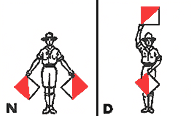 Gerald Holtom, a conscientious objector who had worked on a farm in Norfolk during the Second World War, explained that the symbol incorporated the semaphore letters N(uclear) and D(isarmament). He later wrote to Hugh Brock, editor of Peace News, explaining the genesis of his idea in greater, more personal depth:
Gerald Holtom, a conscientious objector who had worked on a farm in Norfolk during the Second World War, explained that the symbol incorporated the semaphore letters N(uclear) and D(isarmament). He later wrote to Hugh Brock, editor of Peace News, explaining the genesis of his idea in greater, more personal depth:
‘I was in despair. Deep despair. I drew myself: the representative of an individual in despair, with hands palm outstretched outwards and downwards in the manner of Goya’s peasant before the firing squad. I formalised the drawing into a line and put a circle round it.’
Eric Austin added his own interpretation of the design:
‘the gesture of despair had long been associated with the death of Man and the circle with the unborn child.’
Gerald Holtom had originally considered using the Christian cross symbol within a circle as the motif for the march but various priests he had approached with the suggestion were not happy at the idea of using the cross on a protest march. Later, ironically, Christian CND were to use the symbol with the central stroke extended upwards to form the upright of a cross.
This adaptation of the design was only one of many subsequently invented by various groups within CND and for specific occasions — with a cross below as a women’s symbol, with a daffodil or a thistle incorporated by CND Cymru and Scottish CND, with little legs for a sponsored walk etc....
There have been claims that the symbol has older, occult or anti-Christian associations. In South Africa, under the apartheid regime, there was an official attempt to ban it. Various far-right and fundamentalist American groups have also spread the idea of Satanic associations or condemned it as a Communist sign....
Although specifically designed for the anti-nuclear movement it has quite deliberately never been copyrighted. No one has to pay or to seek permission before they use it. A symbol of freedom, it is free for all. This of course sometimes leads to its use, or misuse, in circumstances that CND and the peace movement find distasteful. It is also often exploited for commercial, advertising or generally fashion purposes. We can’t stop this happening and have no intention of copyrighting it. All we can do is to ask commercial users if they would like to make a donation. Any money received is used for CND’s peace education and information work.”
The Committee to Help Unsell the War
In 1969, Arkansas Senator J. William Fulbright, announced the results of his investigation into the Defense Department’s lavish spending on propaganda and self-promotion during the Vietnam War.
Mitchell Hall writes in Unsell the War: Vietnam and Antiwar Advertising, (Historian, Autumn 1995):
“From 1959 to 1969, the Pentagon’s public relations expenditures increased 1,000 percent to an acknowledged $27.9 million, a figure Fulbright called ‘conservative.’ With this financing and a full-time public information force of 2,800 people, the military enjoyed overwhelming access to the public. In 1968 the navy and marines sent over 2.8 million news releases to 12,000 print and broadcast media outlets, in 1969 armed forces performances ranging from musical groups to aerial demonstrations played to audiences estimated at 20 million, and over 360 commercial and educational television stations used the U.S. Army-produced TV show ‘Big Picture.’ The potential influence on public opinion and foreign policy was enormous.
U.S. presidents from Harry Truman to Richard Nixon had also tried to persuade the public that events in Indochina demanded a U.S. military presence. Their efforts initially succeeded, but by the late 1960s millions of Americans had publicly demonstrated their rejection of a policy that had brought increasing sacrifice, destruction, and stalemate. Nixon’s Vietnamization policy, which gradually removed U.S. ground troops but escalated the bombing, partially defused antiwar activity by early 1971. Decreasing U.S. casualties convinced many people that the war was winding down. Although massive public demonstrations occurred less frequently than before, citizens in the early 1970s continued to work to end the war in numerous and creative ways.
On February 23, 1971, CBS broadcast the documentary “The Selling of the Pentagon.”
“Reiterating many of the points addressed in Fulbright’s report, this hour-long program examined the Defense Department’s public relations efforts that, in addition to recruiting volunteers and providing information, marketed a specific interpretation of the Vietnam War and the cold war to the U.S. public....
The military establishment annually arranged hundreds of public contacts that included shopping mall exhibits, Green Beret hand-to-hand combat demonstrations, and tours by flight teams such as the Thunderbirds. In clear violation of regulations, a select group of colonels avidly promoted the U.S. presence in Vietnam in speeches they gave around the country. The Defense Department also provided weekend guided tours of military installations to VIPs, who could observe war games from a grandstand and personally fire tank guns and artillery.
Films also propagated the military’s ideology. The Pentagon cooperated with Hollywood producers who portrayed the military favorably and had celebrities and journalists narrate some of its own movies....
The Defense Department achieved its widest exposure through the news media. Daily briefings to the national press yielded only carefully selected information from the Pentagon’s public relations division. The armed forces also maintained their own media arm, producing over two million press releases each year. Local newspapers generally snapped up uncritically this flood of news about the awarding of medals and promotions. Military television crews provided combat footage to supplement network coverage but often staged the action. Similarly military officials frequently held pre-interview briefings with soldiers in the field to ensure a standard acceptable story before allowing network TV reporters access to them. CBS questioned the impact on a democratic society and free press of a vast military information system that portrayed violence as glamorous, advertised expensive weapons like cars, and presented biased opinion as fact.”
Ira Nerken, a junior at Yale University studying political science, missed the initial broadcast of ”The Selling of the Pentagon” but read about the controversy it provoked. He decided that the war could be ‘unsold’ to the American public. Print ads had occasionally appeared in leading newspapers, and ad hoc groups produced some radio and television spots, but the advertising world had never been tapped on a large scale.
After discussing his ideas with an instructor at Yale, the instructor introduced him to David McCall, president of LaRoche, McCaffrey & McCall, an ad agency in New York. McCall and James McCaffrey, the agency’s chair, quickly organized a team that produced a poster and letter of explanation seeking support for a campaign to unsell the war. These were sent to 80 executives in 60 agencies.
The initial poster featured a drawing of the Pentagon and the headline, “Help unsell the war.” It read:
“C.B.S. recently devoted an hour to documenting the enormous advertising and public-relations job the Pentagon has done to sell the American public its version of the war. A group of students and faculty at Yale University are asking the men and women of the advertising agency business who disagree with the Pentagon’s version of the war to create advertising in all forms that will help unsell the war.”
The letter closed:
“Needless to say, we are not interested in cheap, superficial, anti-American work, we are interested in thoughtful and honest advertising, created by people who love their country.
I hope you will agree with me that this is a vital contribution which our business can make. If you do not agree, I can understand that, too. But the Pentagon’s side of the story has been ably and massively told. Ours has not.”
 Interested ad executives were invited to briefing at Yale University on April 3, 1971.
Interested ad executives were invited to briefing at Yale University on April 3, 1971.
“Over two hundred New York advertising people attended the early April briefing at Yale’s law school auditorium. Paul Warnke, former assistant secretary of defense, and Morton Halperin, former deputy assistant secretary of defense, explained Nixon’s Vietnam policies, and both urged setting a deadline for total withdrawal of U.S. troops. A representative of Vietnam Veterans Against the War discussed war crimes and problems veterans faced. A member of Concerned Asian Scholars described corruption within the Saigon government and the spreading antiwar feeling in South Vietnam. A person from the Herbicide Assessment Commission to South Vietnam showed slides of defoliation and crop destruction, and a former ABC correspondent in Vietnam detailed the strained relationship between the press and the military. Perhaps the most influential speaker was Milton Rosenberg, professor of social psychology from the University of Chicago. He identified the constituencies most ambivalent about the war and the arguments most likely to turn them against it: the deaths of U.S. troops, the economic consequences for the United States, and the creation of national discord.”
After the briefing, the attendees were asked to produce ads to be reviewed on May 1 by a panel that included Kingman Erewster, president of Yale; Mort Halpern, former Deputy Assistant Secretary of Defense; Dr. Edwin Reischauer, former Ambassador to Japan, and Gen. David M. Shoup of the United States Marine Corps (retired.) The panel would evaluate the ads and eliminate those that were inaccurate, unfair, or inferior.
On Memorial Day, May 31, the ads and commercials were to be displayed and distributed to the media to run as a public service.
Over 300 writers, artists, directors, and producers from nearly 50 ad agencies contributed an estimated $1 million of time and expenses. As of June 8, 1971, 125 print ads, 33 TV commercials and 31 radio spots had been produced. Given the expense of reproducing the ads, only a handful were sent to media outlets.
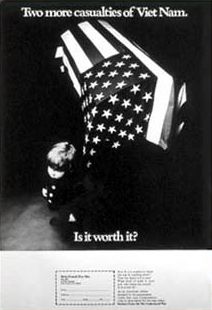 Though the Committee never did convince the major broadcast networks to air the ads, over 100 TV stations and 350 locally owned radio stations around the U.S. did run the spots. During the summer of 71, Nerken was able to arrange free time on 285 billboards around the country. Many of the ads urged people to elect representatives who would vote to end the war by the end of the year.
Though the Committee never did convince the major broadcast networks to air the ads, over 100 TV stations and 350 locally owned radio stations around the U.S. did run the spots. During the summer of 71, Nerken was able to arrange free time on 285 billboards around the country. Many of the ads urged people to elect representatives who would vote to end the war by the end of the year.
“With its attention focused on production rather than marketing, Unsell encountered additional problems inherent in the campaign. It lacked a built-in constituency or the organizational resources to conduct a national distribution effort. Local media felt little pressure to run ads offered by mail from New York. The result was a relative lack of success in getting messages on the air and in print. Because many ads focused on U.S. casualties, the sell became harder as Vietnamization brought more U.S. troops home in favor of an escalated air war, diluting one of the Unsell campaign’s central themes.”
In 1972, the expense and demands of the campaign ultimately led to its transfer to Clergy and Laymen Concerned, the nation’s largest religiously oriented antiwar organization. The focus of ad production also shifted from New York City to Hollywood. The CALC’s network of local chapters were also able to decentralize the task of contacting local media for free time and space. National organizations such as the American Friends Service Committee, Another Mother For Peace, and the Fellowship of Reconciliation also urged their members to get involved in the campaign.
In addition to the decline in U.S. casualties, the ongoing financial burden of the campaign and the 1972 presidential election slowed the momentum of the project which ultimately ended after the reelection of President Nixon and his announcement in January 1973 of an accord with North Viet Nam to end American involvement in Indochina.
The Library of Congress has several thumbnail images of posters produced by the Committee. Click on ‘Preview Images.’
A Bug’s Life
A “union bug” is a tiny logo used to designate items that have been produced with union labor.
“Printers have been know to use a bug to designate union labor as early as October 15, 1891, when it appeared at the head of the editorial column of the Compositors (I.T.U.) Typographical Journal. The first known use of a bug in commercially-produced documents was by the [International Printing Pressmen Union of North America] in May 1893.
 The union label has at least five purposes:
The union label has at least five purposes:
- It is a protection against anti- or non-union shops that might otherwise profess union working conditions.
- It can be part of a public-relations campaign to induce customers to buy union-made products.
- It is a sign of good workmanship and quality standards.
- It is badge of union prestige to attract new members.
- It is warning against trespass by competitive unions.
Bugs usually appear discreetly at the corner of a back page or at the bottom of a title page.... The most common union bug is that of the Allied Printing Trades. It signifies that all aspects of the work, from typesetting to finishing, were performed by union labor. This bug contains several important pieces of information. The lower arc contains the geographic region, which may be a city ("New York") or a broader area ("Northern California"). Coupled with that location is a shop name or number. The number is permanently assigned when the shop is organized. A regional list of union shops, indexed by shop name and number, is available from the local Printing Trades Council. A national database is also now available on-line.”
...
So in addition to recession, years of declining union membership, and an increasingly hostile organizing environment, the union bug, proud mark of much hardship and struggle, is being written out of the history of the documents that bear it. While archivers and catalogers of printed matter note publisher, printer, city and date of printing, they almost always exclude information encoded in the union bug and even fail to mention the bug at all.
“Most catalogers have no idea what to do with them. Full cataloging of bug-bearing documents either omits mention of them at all or indicates only that which is recognizable.... Direct inquiry confirmed that ‘The Library of Congress has not sought to describe (this) level of detail... when encoding historical documents with the American Memory DTD [Document Type Definition].’...
The authoritative source on cataloging guidelines is the Anglo American Cataloging Rules (AACR). According to Michael Gorman, Dean of Libraries at C.S.U. Fresno and editor of the AACR, ‘I can safely say that the Union Bug is not mentioned in any English-language cataloguing code.’
A review of the 1988 edition provides several potential loci for specifying union bug information.... Given that the union bug is a valuable piece of cataloging data, I would like to propose that it be formally included in AACR, MARC, EAD, and other archival cataloging protocols. The default option should be that absence of information means that there is no bug. If a bug is present, however, the relevant information should have a designated place to record it.”
Delirious New York
Twin Towers steel set for US warship:
“Steel salvaged from the wreckage of the World Trade Center in New York has been sent to a Mississippi shipyard to be used in the construction of a new US warship.
According to reports, a massive structural beam which supported the south tower will be used to build USS New York, an amphibious vessel capable of carrying more than 1,000 soldiers.”
The $800-million vessel should be ready for active duty in 2007.
Underexposed
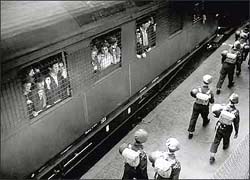 The people in the black and white photo behind the bars of the boxcar in the 1940’s German train station are not Jews off to the camps to be killed. They are indeed German Jews off to a camp, but the photo was taken after the end of war, the soldiers on the platform are British, and the passengers are survivors of Nazi concentration camps, denied entry into Palestine. Here, they are being transported from Hamburg docks to the Poppendorf detention camp.
The people in the black and white photo behind the bars of the boxcar in the 1940’s German train station are not Jews off to the camps to be killed. They are indeed German Jews off to a camp, but the photo was taken after the end of war, the soldiers on the platform are British, and the passengers are survivors of Nazi concentration camps, denied entry into Palestine. Here, they are being transported from Hamburg docks to the Poppendorf detention camp.
The photo and its story are reproduced in Underexposed. From Vision On Publishing:
“Underexposed tells the stories behind the photographs which determine our view of history, providing a reality check on alleged events from the last hundred years and documenting the struggle of the powerful to contend with rival cultural forces of media and information. Reclaimed from the trash cans of the Second World War. From the cruelty of Stalin’s Russia and fundamentalist chaos in Iran to the horrors of the Gulf war and perspectives on September 11th — even Hitler’s preening speech rehearsals come back to argue with his self-made myth. Via disgruntled starlets, ecological destruction and US nuclear tests, Underexposed gathers together some of the most ideologically dangerous photographs ever taken and releases them to haunt the increasingly manipulated, re-touched present.”
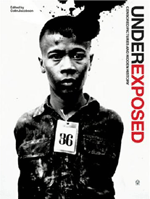 I found the book on the front table at St. Mark’s Books, mixed with the latest compilations on cyber-typography, club flyers, erotica, and graphic novels. The juxtaposition is continued on the publisher’s Web site. Among the publisher’s list of glossy photo books of rock stars, fashion, erotica, and a celebration of the Manchester City Football Club (and its fans), Underexposed seems a bit like war porn. The design of the book is certainly less than sober, full of dramatic, oversized, full-bleed spreads and a hip sans serif typeface. Each photo is provided with some background, but the captions only allow so much space.
I found the book on the front table at St. Mark’s Books, mixed with the latest compilations on cyber-typography, club flyers, erotica, and graphic novels. The juxtaposition is continued on the publisher’s Web site. Among the publisher’s list of glossy photo books of rock stars, fashion, erotica, and a celebration of the Manchester City Football Club (and its fans), Underexposed seems a bit like war porn. The design of the book is certainly less than sober, full of dramatic, oversized, full-bleed spreads and a hip sans serif typeface. Each photo is provided with some background, but the captions only allow so much space.
The bottom line: photographs can lie. Particularly those that purport to be objective. Taken out of context, they are cropped, altered, and framed by the context at hand and by cultural assumptions. And page after page, the flouting of taboo and power starts to flatten out. Like all the speakers in the corner of Hyde Park, all ideologies become equivalent.
That said, the book does rouse a healthy dose of skepticism. It also crosses into the terrain of Barthes’s Mythologies, an examination of connections between language, imagery, ideology, and power and a wandering interrogation of “the obvious.”
From a review in The Guardian:
“In one of the most shocking images, taken from the Sudanese famine of 1984, Wendy Wallace photographed the photographers at work snapping an emaciated child who had been brought out to sit in the dirt precisely for that image.
It is a theme that recurs in Alex Webb’s pictures of the American invasion of Haiti. A line of US troops lies dramatically - heroically - on the Tarmac at Port au Prince airport aiming their weapons at an unseen enemy. Most media organisations showed this image. Webb’s version shows the reality: the only figures are half a dozen and more photographers and cameramen crouched in front of the soldiers, puncturing the dramatic image in a campaign that was to see virtually no opposition to US troops.”
See an excerpt from the forward to the book, some photos from the book, or listen to an audio interview with Colin Jacobson, former photo editor for a number of British news magazines and editor of Underexposed.
...
Also of note, The Commissar Vanishes: The Falsification of Photographs in Stalin’s Russia, an small online exhibit of doctored photos and propaganda posted by the Newseum. Shown here, Stalin with Nikolai Yezhov, commissar of water transport, before and after he was purged.
Forget About It


Drapetomanic sent me a link to a page on Eszter Hargittai’s Web site that has a couple of screen caps of Web sites before and after September 11, 2001.
The three site designs feature the Manhattan skyline whose twin towers were quickly airbrushed from the pages. What’s striking is that the changes occurred within three months of the attacks, as if the polite thing to do is to immediately pretend the towers did not exist.
...
On the flip side, the official Operation TIPS Web page has vanished. Here’s a cached version. The disappearance is probably related to Section 880 of the Homeland Security Act of 2002 which declares that
“Any and all activities of the Federal Government to implement the proposed component program of the Citizen Corps known as Operation TIPS (Terrorism Information and Prevention System) are hereby prohibited.”
Though that didn’t stop New York State from starting their own.
...
Also gone from the Web is the scary logo and much information from the site of the Defense Department’s Total Information Awareness program. See a couple of screencaps of the site before and after. From news.com:
“If fully implemented, TIA would link databases from sources such as credit card companies, medical insurers, and motor vehicle databases for police convenience in hopes of snaring terrorists.
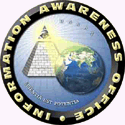 First, biographical information about the TIA project leaders, including retired Adm. John Poindexter, disappeared from the Defense Department’s site last month. A mirror that one activist created from Google’s cache shows the deleted information included four resumes listing past work experience but no addresses or contact information.
First, biographical information about the TIA project leaders, including retired Adm. John Poindexter, disappeared from the Defense Department’s site last month. A mirror that one activist created from Google’s cache shows the deleted information included four resumes listing past work experience but no addresses or contact information.
Then, sometime in the last week, the TIA site shrank still more and some links ceased to work. The logo for the TIA project—a Masonic pyramid eyeballing the globe—vanished, a highly unusual step for a government agency. So did the TIA’s Latin ‘scientia est potentia’ slogan, which means ‘knowledge is power.’...
The disappearing documents come as the TIA has become a lighting rod for criticism and as online activists have been turning the tables on Poindexter by reposting his personal information and home telephone number as widely as possible....
The TIA project became public early this year when President Bush chose Poindexter, who was embroiled in the Iran-Contra scandal, to run the Information Awareness Office. But criticism of the project from privacy advocates and newspaper editorial pages has spiked in the last month, and the Web deletions appear to have been in response to the increased public scrutiny.”
HIV / AIDS / WWW
“Each December 1, World AIDS Day, the creative community observes A Day With(out) Art, in memory of all those the AIDS pandemic has taken from us, and in recognition of the many artists, actors, writers, dancers and others who continue to create and live with HIV and AIDS.
A Day With(out) Art was created by the group Visual AIDS in New York City.
 For the last several years, Creative Time has organized a Day With(out) Art observance on the worldwide web, encouraging diverse website designers and administrators to darken their site and convey AIDS prevention and education information to their visitors.
For the last several years, Creative Time has organized a Day With(out) Art observance on the worldwide web, encouraging diverse website designers and administrators to darken their site and convey AIDS prevention and education information to their visitors.
In 1999, more than 50 webloggers took part in a project called a Day With(out) Weblogs. In 2000, nearly 700 personal weblogs and journals of all sorts participated. In 2001, the number was over 1,000. The personal web publishing community — weblogs, journals, diaries, personal websites of every kind — has continued to grow and diversify.
Once again, everyone who produces personal content on the web is invited to participate a global observance of World AIDS Day. In recognition of the variety of sites participating — E/N sites, weblogs, journals, newspages and more — and to differentiate it from other, similar endeavors, a Day With(out) Weblogs became Link and Think.”
Despite the corny name, Link and Think is one of the more effective online grassroots marketing campaigns I’ve seen. While a Day With(out) Weblogs was more of a memorial and show of solidarity, Link and Think also takes a more forward looking view.
Of the Web logs I check regularly, MetaFilter posted decent set of links. The facts, stories, and images are chilling, but it’s also nice to see a bit of perspective — for instance, asking why AIDS dominates the public health debate.
American Concentration Camps

Blamed for an attack on America, non-white Americans and residents of foreign descent had become so hated that in February 1942 the President ordered their arrest and detention at “relocation centers” around the country. 110,000 men, women, and children were removed from their homes, rounded up at gun point, and locked up for the next three years.
From a Web site on Owens Valley History, the site of the Manzanar detention center:
“Two-thirds were first-generation American citizens. They lived in American cities, attended American schools, and thought of themselves as Americans... They were removed from their homes, schools, and businesses, and brought to Manzanar and nine other camps like it.... A few were second-generation Americans.... Neither they nor their parents had ever known any other life than their life in the United States.
Almost a third of the prisoners were Japanese citizens, resident aliens by definition of the U.S. immigration law.... All of this group had lived in the United States at least eighteen years, since American borders were closed to Japanese immigrants in 1924. All had been specifically barred from applying for American citizenship. The right to become an American citizen was not allowed to the Japanese until 1952, when quotas were introduced.”
The Library of Congress Web site features a collection of 244 photographs of Japanese-American internment at Manzanar taken by reknown landscape photographer Ansel Adams. Depicted are scenes of daily life, agricultural scenes, sports and leisure activities, and portraits of the detainees. Browse via the subject index or the thumbnail view.
From the Library page about the collection:
“In 1943, Ansel Adams photographed the Manzanar War Relocation Center at the suggestion of its director, his good friend and fellow Sierra Club member, Ralph Merritt. Adams wanted to contribute to the war effort while at the same time show the loyalty of the Japanese-Americans interned at Manzanar... In 1944, some of these images were published in Adams’ book Born Free and Equal. The book had a limited circulation, perhaps due to the political climate of war-time America. When offering the collection to the Library, Adams said in a letter, ‘All in all, I think this Manzanar Collection is an important historical document, and I trust it can be put to good use...The purpose of my work was to show how these people, suffering under a great injustice, and loss of property, businesses and professions, had overcome the sense of defeat and despair by building for themselves a vital community in an arid (but magnificent) environment.’”
The internment camps were small planned communities built with volunteer, contract, and forced labor on the site of a ghost town.
“The center was located at the former farm and orchard community of Manzanar. Founded in 1910, the town was abandoned when the city of Los Angeles purchased the land in the late 1920s for its water rights. The Los Angeles aqueduct, which carries Owens Valley water to Los Angeles, is a mile east of Manzanar.”
In addition to vital necessities of food and shelter, the camp had its own school, church, factories, hospital, and even a local paper. See this essay for details on the design and operations of the camp.
 40 years after the closing of the camps, the United States government conceded that the relocation was based on racial bias rather than on any true threat to national security. 50 years later in 1992, President Bush offered reperations and an apology.
40 years after the closing of the camps, the United States government conceded that the relocation was based on racial bias rather than on any true threat to national security. 50 years later in 1992, President Bush offered reperations and an apology.
Congress established the Manzanar National Historic Site, containing 550 acres, on March 3, 1992. It is currently administered by the National Park Service, under the U.S. Department of Interior. See the Park Service Web site.
Nearly 60 years after the war, Yoshie Hagiya, age 77, Oxnard High class of 1942, received her school’s valedictorian honors.
Murals and Anti-Murals in Nicaragua
Two years ago I spent my birthday in Nicaragua. I was traveling with a delegation organized by Peaceworks, meeting with local groups and learning about the country and its struggles. As the eight of us bounded along the dusty roads in the back of a white pickup truck, one could periodically spot these odd abstract murals along walls and fences. They were vertical, horizontal, and diagonal stripes in pastel colors. It turns out the stripes had been painted over Sandinista slogans and murals under orders from right-wing President Arnoldo Aléman. See Nicaraguan Murals 1930-2000 on the Stanford site for a hint of what was lost.
The painted stripes reminded me of Sol LeWitt and Sean Scully. A fizzy gallery world rhetoric of geometry instead of engagement with the world at large. And that’s just the way the CIA likes it. From the Monthly Review:
“[The] CIA and its allies in the Museum of Modern Art (MOMA) poured vast sums of money into promoting Abstract Expressionist painting and painters... What the CIA saw in Abstract Expressionism was an ‘anti-Communist ideology, the ideology of freedom, of free enterprise. Non-figurative and politically silent it was the very antithesis of socialist realism’. They viewed Abstract Expressionism as the true expression of the national will. To bypass right-wing criticism, the CIA turned to the private sector (namely MOMA and its co-founder, Nelson Rockefeller, who referred to Abstract Expressionism as ‘free enterprise painting.’)”
See also articles in Salon and the New York Times.
Needless to say, the CIA also poured of money, weapons, and comics into toppling the Sandinistas.
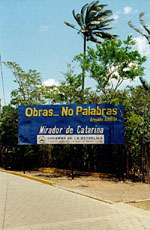
 We rode through the streets paved with hexagonal ‘Somoza bricks’ crumbling from the wear and tear. The Somoza government had laid the bricks, having purchased them from factories he also owned.
We rode through the streets paved with hexagonal ‘Somoza bricks’ crumbling from the wear and tear. The Somoza government had laid the bricks, having purchased them from factories he also owned.
These stark blue billboards were everywhere. “Obras No Palabras” painted in the same yellow italic sans serif and listing some local government financed project. “Works not Words,” a kind of anti-propaganda propaganda promoting the good will of the State and attempting to short-circuit debate.
And indeed, Aléman’s works have spoken loudly. This past September, Nicaragua’s Attorney General charged Aléman and 13 members of his family and former administration “with money laundering, fraud and other crimes.”
I bet he never saw that coming from his own former vice-president.




